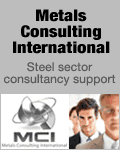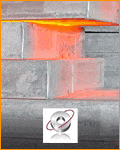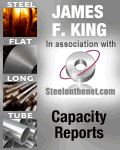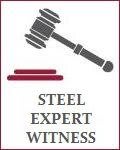Steel Industry Glossary of Terms: D-H
Technical glossary - jargon made easy
| Term | Glossary Explanation |
| D-bar | Deformed bar - the most common form of reinforcing bar |
| Decarburisation | The loss of carbon at the surface of steel. It is caused by exposure of the surface to oxidising conditions at high temperature |
| Deep drawing steel | Low carbon steel strip with a microstructure to enable it to be extensively pressed or drawn without tearing or failure |
| DMTU | Dry metric tonne unit. A metric tonne unit is equivalent to 1% of a metric tonne (i.e. 1% of 1000 kg) and equals 10 kilograms. Iron ore prices are commonly expressed in terms of cents per DMTU. |
| DNV | Det Norske Veritas - independent foundation based in Norway with objective of safeguarding life, property, and the environment - with an important role in product certification |
| DRI | Direct reduced iron - a residual-free scrap substitute |
| EAF | Electric arc furnace - a furnace that melts (and thus recycles) steel scrap for the production of liquid steel using electrical power |
| ECSC | European Coal and Steel Community - the original version of what is now known as the European Community. Founded by the Treaty of Paris in 1952, the ECSC was based on the principle of member nations sharing their coal and steel resources |
| ECX | European Climate Exchange - marketplace for trading carbon dioxide emissions |
| EGL | Electrogalvanised - typically used to describe electrolytically zinc coated sheet steel |
| EIA | Environmental impact assessment - an appraisal of the environmental impact of a project during both construction and operation phases, and of future compliance with relevant regulatory requirements |
| Electrical steel | Cold rolled strip with containing up to 6% Si and cold rolled and annealed to give specific magnetic properties and high electrical resistivity. They can be grain-oriented (GO) to give preferred magnetic properties in the rolled direction or non-grain oriented (NGO) to give uniform properties. The strips or laminations are usually lacquer coated to increase electrical resistivity when assembled into cores for transformers, electric motors, etc |
| EPC | Engineering Procurement and Construction - A type of building contract that is often used for complex projects whereby which the builder (or EPC contractor) delivers the completed project on a turnkey basis. |
| ERW | Electrical resistance weld: welding by the process of passing of an electric current through two metals. Resistance to the current creates heat, melting the metal (often under some force) and thus forming the weld. ERW pipes are typically 1/8-24 inches in diameter [3-600mm] which distinguishes them from large diameter pipe |
| ESTEP | Acronym for European Steel Technology Platform - a body focused on strategic research undertaken for various European and National Research Ministries |
| ESR | Electro-Slag Remelting. (Also known as EFR, electro-flux remelting) method of producing refined ingots with fewer inclusions and reduced segregation. The process consists of melting a cast or wrought electrode through a molten slag and solidifying in a water cooled copper mould. An electrical current is passed through the electrode and the electrical resistance of the slag provides the heat to melt the electrode. The resultant ESR ingot is then conventionally hot forged or rolled |
| ETS | Emissions trading scheme - a system for reducing carbon dioxide emissions, based on pricing of CO2 output |
| Ferroalloy | Alloy of iron with high proportion of an element such as nickel, chromium, molybdenum, vanadium, manganese etc that used in the production of steel |
| Finex ® | Smelting reduction process based on reduction and melting of non-agglomerated iron ore fines using thermal coal [i.e. non-coking coal] as the main energy source |
| FIOR | Direct reduction process based on the use of iron ore fines to make iron units. FIOR is an acronym for Fluidized Iron Ore Reduction |
| Flux | A substance such as limestone which is added to a furnace and which reacts with impurities to form a slag |
| Full hard | Refers to cold rolled sheet steel that has not been softened by annealing |
| GA | Common abbreviation for galvannneal |
| Galvanneal | Refers to a sheet steel product that is annealed after hot dip galvanizing with zinc. The additional annealing step produces an external zinc-iron alloy coating which gives the coated steel product exceptional corrosion resistance |
| Gauge | Another term for the thickness of sheet steel |
| GI | Galvanised iron, a common name for hot dip galvanised steel |
| Greenhouse gas | Name collectively refers to a group of gases which trap radiation leaving the Earth. The main GHGs responsible for the resulting climate change are carbon dioxide CO2, methane CH4 and nitrous oxide N2O. The full GHG list also includes water vapour H20, ozone O3, sulphur hexafluoride SF6 and several other halogen-containing hydrocarbons |
| Grey iron | Basic form of cast iron that is relatively easy and inexpensive to produce. Grey iron ['gray iron'] is suitable for making a wide range of castings including valve, pump, rail and auto applications |
| Hardenability | The hardenability of a steel is its ability to be hardened at depth in quenching. As a general rule, the hardenability of low alloy steels increases with alloy content |
| Hardness | Hardness is a measure of the resistance of a steel to indentation and is related to the maximum strength of the steel. Typical hardness measurement scales are Vickers, Brinell and Rockwell |
| HBI | Compacted DRI, formed into briquettes for easier handling. The briquettes are commonly known as hot briquetted iron |
| HDG | Hot dip galvanised - describes a zinc coating obtained by dipping steel sheet into a bath of molten zinc |
| HICP | Humber Industrial Cluster Plan - a collaborative initiative centred around the east coast of Northern England that plans to enable a series of industrial partners (including firms from the iron and steel, chemicals, power generation and other sectors) to attain net zero carbon emissions by 2040, using offshore wind power, carbon capture and storage as well as hydrogen |
| High speed tool steels | Glossary term refers to a range of metal-cutting tool steels that retain their hardness at red heat. The compositions are based upon high carbon steels with significant additions of W, Mo, V, Cr and in some cases Co |
| Hismelt | Direct ironmaking process, based on use of iron ore fines and non-coking coal for the production of hot metal |
| HMS1, HMS2 | HMS1 and HMS2 are the preferred forms of scrap for the production of steel. Both are defined as obsolete scrap - which is generated when a steel product comes to the end of its working life. HMS denotes 'heavy melting scrap' [sometimes 'heavy melting steel']. HMS1 comprises clean iron and steel with a minimum thickness of 1/4" and a defined maximum size [e.g. 60"x24" wide]. HMS2 is similarly defined but has a minimum thickness of 1/8" |
| Hot metal | Another term for pig iron (see glossary entry below) - the product made in a blast furnace |
| Hot band | North American term for hot rolled coil |
| HRC | Common abbreviation for hot rolled coil |
| HSAW | Helical submerged arc welded pipe - a type of large diameter pipe, usually over 20 inches in diameter. Also known as SSAW pipe |
| HSLA | High strength low alloys: a type of alloy steel that provides better mechanical properties or greater resistance to corrosion than carbon steel |
| HSM | Common abbreviation for hot strip mill - used for the production of hot rolled steel coil |
| HYBRIT | Hydrogen breakthrough ironmaking technology. The acronym was first adopted by Vattenfall, SSAB and LKAB who in 2016 set up a joint venture company called HYBRIT Development. The technology seeks to attain completely fossil-free steelmaking by 2035. |
Quick Navigation
WEBSITE HUBS
Steel News Hub
Price Hub
Knowledge Base
History Hub
Advice Hub
Supplier Hub
Technology Hub
M&A Data Hub
Trump Tariffs NEW
WEBSITE HUBS
Steel News Hub
Price Hub
Knowledge Base
History Hub
Advice Hub
Supplier Hub
Technology Hub
M&A Data Hub
Trump Tariffs NEW
© 2001 -
2025 Steelonthenet.com. All rights reserved.
To contact us about this steel industry glossary of terms please email info@steelonthenet.com.
To contact us about this steel industry glossary of terms please email info@steelonthenet.com.











